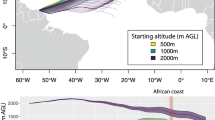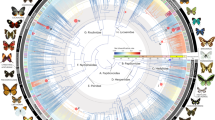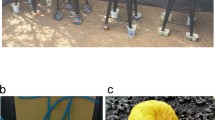Abstract
IN the 103rd number of NATURE there are two notices of remarkable butterfly flights in America, and it is asked “Where the yellow butterflies are going?” Mr. R. Spruce, in “Notes on some Insect and other Migrations observed in Equatorial America” (published in the Journal of the Linnean Society, vol. ix. No. 38, read June 6, 1867), has the following curious account of similar flights, which, he says, have also been described by Messrs. Edwards, Wallace, and Bates: “The first time that I fell in with such a migration was in November 1849, rear the mouth of the Xingú, when I was travelling up the Amazon from Parà to Sautareon. . . We saw a vast multitude of butterflies flying across the Amazon from the northern to the southern side in a direction from about N.N.W. to S.S.E. They were evidently in the last stage of fatigue. They were all of common white and orange yellow species, such as are bred in cultivated and waste grounds, and having found no matrix whereon to deposit their eggs to the northward of the river (the leaves proper for their purpose having probably been already destroyed or at least occupied by caterpillars) were going in quest of it elsewhere. The very little wind there was, blew from between E. and N.E., therefore the butterflies steered their course at right angles to it; and this was the case in subsequent flights I saw across the Amazon. . . But the most notable circumstance is that the movement is always southward. . . Since my return to England I have read Mr. Bates's graphic description of a flight of butterflies across the Amazon, below Obidos, lasting for two days without intermission during daylight. These also all crossed in one direction, from north to south. Nearly all were species of Callidryas, the males of which species are wont to resort to beaches, while the females hover on the borders of the forest and deposit their eggs on low-growing, shade-loving Mimosas. He adds, ‘the migrating hordes, so far as I could ascertain, are composed only of males.’ It is possible, therefore, that in the flights witnessed by myself the individuals were all males - in which case the flights should probably be looked upon, not as migrations, but dispersions, analogous to those of male ants and bees when their occupation is done, and they are doomed by the workers to banishment, which means death. In the case I am about to describe, however, the swarms certainly comprised both sexes, although I know not in what proportion; and their movements were more evidently dependent on the failure of their food.
This is a preview of subscription content, access via your institution
Access options
Subscribe to this journal
Receive 51 print issues and online access
$199.00 per year
only $3.90 per issue
Buy this article
- Purchase on SpringerLink
- Instant access to full article PDF
Prices may be subject to local taxes which are calculated during checkout
Similar content being viewed by others
Rights and permissions
About this article
Cite this article
M., T. The Flight of Butterflies. Nature 5, 101 (1871). https://doi.org/10.1038/005101a0
Published:
Issue date:
DOI: https://doi.org/10.1038/005101a0



